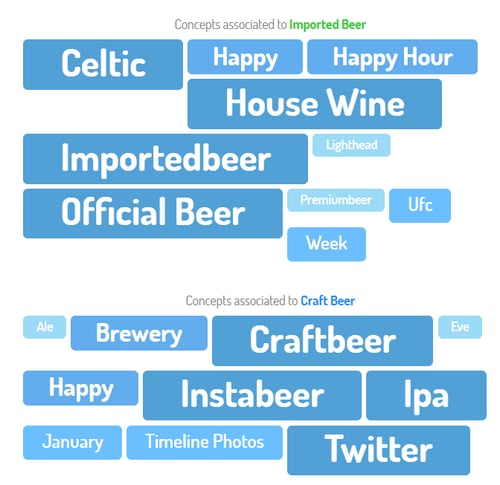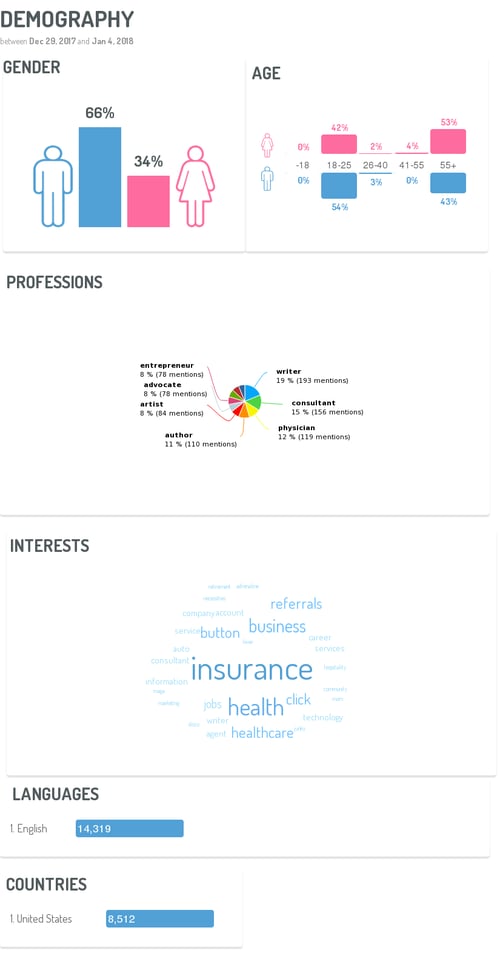The Benefits of Customer Profiling for Brands
Brands have been collecting data on customers, consumers and prospects for as long as they’ve been marketing to them. Customer profiling is invaluable in developing differentiated products and services. Netflix, for example, uses algorithms to customize their content based on the profiles and consumption patterns of individual users. As the influence of social media continues to grow alongside listening, analysis and insights tools, so too does the volume of exploitable data offered across the internet. The availability of data is not the issue - the challenge is elsewhere: fostering an ability to use analytics and detect relevant and operational insights to feed an insight-driven approach to marketing for different consumer profiles.
I. The Importance of Customer Profiling
1. What Does Customer Profiling Offer?
When consumers post on Instagram, Facebook or Twitter, they provide marketers with useful information from online behavior. The post may offer keywords, hashtags, images, emojis, or the user’s profile bio. From this data, social intelligence tools can extract rich socio-demographic information, from the user’s age and gender to their interests, tastes, and lifestyle. This is the first axis of social data fueled customer or consumer profiling.
The second axis, which complements the first, consists of an analysis which filters messages relevant to a business according to preset criteria. These criteria might include the theme of conversation, the type of social channel on which these conversations occur, the country, region, or city of origin, their associated sentiments, or the level of user influence. Data may also be organized and aimed at solving a particular business problem - improving the customer journey, for example. By analyzing the wide range of information available to them with social intelligence, marketers can categorize customers into highly granulated segments to help the business identify opportunities.
2. The Benefits of Social Data
One of the primary benefits of social data its level of spontaneity in comparison to data collected from a survey, questionnaire or interview. The opinions reflected on social media are less contrived than those collected from a survey. Conversely, there is value to the anonymity - consumers may be more willing to divulge personal information if their name is not attached to a survey.
Digimind performed a study on New Year’s resolutions posted on social media and compared them to data collected from a classic survey. Across social channels, resolutions tended to relate to spending more time with family or getting in better shape. The anonymous survey found consumers answering far more personally, with many responses expressing a desire to earn more money, for example. Approaching data collection with a two-fold method: a survey complemented with social intelligence monitoring offers marketers far more comprehensive and honest consumer profiling insight.
 A sample demographic analysis of those using the hashtag #resolutions for New Years, via Digimind Social.
A sample demographic analysis of those using the hashtag #resolutions for New Years, via Digimind Social.
II. The Applications of Customer or Consumer Profiling
1. Use Profiling to Understand & Segment Your Target Audience
Social listening tools enable brands to identify the market segments or demographics with the most potential, understand the expectations of their customers, and to reach them on their favorite channels to express themselves.
A Digimind client representing an international group of alcohol brands uses social listening for consumer profiling. The objective of one of their social listening projects is to reposition their beer business in order to target fans of popular music. The business wanted to expand its positioning after feeling that their brand image may be perceived as polarizing to some. In achieving this goal, our client focused on sponsorship campaigns surrounding music and street art festivals and biker events. A unique business challenge emerged: generate customer insights by capturing online consumer reviews and creating a consumer profiling strategy to support campaigns aimed at promoting the new market position.
Using a social intelligence tool, the alcoholic beverage group collected social data to segment the market into profiles based on interests, habits, and lifestyles relevant to their beer brands.
 Keywords associated with imported and craft beers, via Digimind Social.
Keywords associated with imported and craft beers, via Digimind Social.Digimind’s social intelligence tool with analytics enabled our client to:
- Analyze consumer conversations regarding relevant beer brands to understand their perceptions
- Collect data regarding customer expectations
- Define the language used by consumers to describe their products, including keywords, slang, common expressions, etc.
- Determine the hashtags most commonly used by relevant consumer segments across social media, especially Instagram, Facebook, and Twitter
- Understand the context of consumption patterns, including possible product associations
- Segment conversations by socio-demographics, customer profiles, topics of interests, and region
- Categorize messages by social media channel in order to adapt engagement strategies to each customer’s experience
- Inform the consumer journey to answer questions like where consumers are searching for information, where they look for opinions, and where they deliver feedback
With this data collection procedure, our client defined four primary segments:
- Students
- Fans of rock and metal music
- Families
- Music festival goers
Profiling consumer successfully enabled our client to adapt the positioning of their offline and online communications, event strategy, and packaging using insights.
2. Customer Profiling for Personalized Communications
Developing brand visibility doesn’t necessarily translate to a larger audience. It can far more effective to specifically target prospects from consumer profiling with the greatest potential to become qualified leads or buying customers. Understanding a high-potential target consumers and reaching them with targeted communications campaigns is far more worth a brand’s focused efforts.
Successfully targeting an audience highly depends on the ability of the marketing team to define key consumer profiles and to research them with social data. A social listening tool enables marketing teams to:
- Analyze online conversations about the products of relevant campaigns and understand customer expectations, consumption patterns, and the language used to discuss them
- Detect socio-demographic characteristics of these consumers in terms of age, gender, interests, profession, and location - information especially valuable during product launch stages. ASUS, for example, has used this approach.
Take the example of a financial business which wanted to develop its brand reputation in order to increase market share with targeted social media advertisements. With social listening, the firm tracked the media behavioral trends of their target audience. After collecting data, the firm categorized their target audience into four main segments. Following this market segmentation, the company was able to successfully reach and covert many prospects into customers.
3. Qualifying Prospects with Customer Profiling
One among the many challenges facing the insurance sector is to develop new business, especially through prospect profiling. What’s more is that policyholders more often want multi-channel brand interactions including personal and digital points of contact. This desire holds especially true among millennials.
A Digimind client, an insurer, uses social intelligence to personalize promotions and communications digitally. Our client builds customer profiles by listening to prospects and current customers within the life and property insurance market. Specifically, they choose to analyze conversations about the general insurance industry, specific insurers, and policyholder contracts. The results were categorized into the following topics:
- Types of prospects (are they insurance professionals, policyholders, etc.)
- Socio-demographics
- Types of contracts (house, motor, health, etc.)
- Insurance brands
 A demographic analysis of online discussion surrounding the insurance industry, via Digimind Social.
A demographic analysis of online discussion surrounding the insurance industry, via Digimind Social.
Our client analyzed relevant conversations to determine on which social platforms the majority of discussions were occurring, which hashtags are most commonly used, which themes were most discussed, by which communities, and on what kinds of social profiles. This analysis revealed that forums and Twitter were the channels on which a majority of conversation was occurring, and helped our client understand the manner in which policyholders tend to discuss the insurance industry online.
A sentiment analysis revealed that a majority of conversation surrounding the insurance industry was neutral, while 10% of conversation had negative sentiment. Regarding commonly discussed topics, many policyholders indicated a desire to learn more about the nature of the insurance industry, types of contracts, and the extent or specificity of claims covered by their policies. Generally speaking, negative mentions of the industry were concerning bad service experiences.
The purpose of categorizing customer messaging thematically was to establish prospect profiles by product, communication channel, and method of information search. On channels like forums, where it can be difficult to find a user’s profile, users will often be more willing to offer information about their living situation. In the case of home insurers, for example, it may be valuable to use social data to determine whether their prospects have roommates, are renting or own their home, or are waiting for a loan. The language used on forums also tends to be more formal than on social media, and the messaging is often more elaborate. Finally, individuals discussing the insurance industry on forums tend to do so after having been in contact with insurance companies while those communicating on channels like Twitter have not necessarily done so.
Following their social intelligence analysis, this insurance business was able to identify five distinct prospect profiles and highlight industry consumption trends, methods of use for insurance products, and customer expectations and needs. The insurer subsequently updated their communications strategies to fit these findings and to use language familiar to the online insurance conversation space.
Target audience refinement, communications customization, and prospect qualifications are only a few of the many applications of social data within a consumer profiling approach to marketing. The applications of social data extend to all phases of the marketing process, including awareness creation, acquisition, conversion, satisfaction, and retention.
How Adolescents Use Social Media

